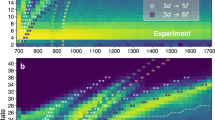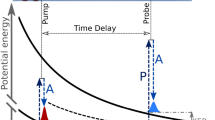Abstract
X-ray free-electron lasers provide unique opportunities for exploring ultrafast dynamics and for imaging the structures of complex systems. Understanding the response of individual atoms to intense X-rays is essential for most free-electron laser applications. First experiments have shown that, for light atoms, the dominant interaction mechanism is ionization by sequential electron ejection, where the highest charge state produced is defined by the last ionic state that can be ionized with one photon. Here, we report an unprecedentedly high degree of ionization of xenon atoms by 1.5 keV free-electron laser pulses to charge states with ionization energies far exceeding the photon energy. Comparing ion charge-state distributions and fluorescence spectra with state-of-the-art calculations, we find that these surprisingly high charge states are created via excitation of transient resonances in highly charged ions, and predict resonance enhanced absorption to be a general phenomenon in the interaction of intense X-rays with systems containing high-Z constituents.
This is a preview of subscription content, access via your institution
Access options
Subscribe to this journal
Receive 12 print issues and online access
$209.00 per year
only $17.42 per issue
Buy this article
- Purchase on Springer Link
- Instant access to full article PDF
Prices may be subject to local taxes which are calculated during checkout





Similar content being viewed by others
References
Emma, P. et al. First lasing and operation of an ångstrom wavelength free-electron laser. Nature Photon. 4, 641–647 (2010).
Young, L. et al. Femtosecond electronic response of atoms to ultra-intense X-rays. Nature 466, 56–61 (2010).
Hoener, M. et al. Ultraintense X-ray induced ionization, dissociation, and frustrated absorption in molecular nitrogen. Phys. Rev. Lett. 104, 253002 (2010).
Fang, L. et al. Double core-hole production in N2: beating the Auger clock. Phys. Rev. Lett. 105, 083005 (2010).
Cryan, J. et al. Auger electron angular distribution of double core-hole states in the molecular reference frame. Phys. Rev. Lett. 105, 083004 (2010).
Doumy, G. et al. Nonlinear atomic response to intense ultrashort X rays. Phys. Rev. Lett. 106, 083002 (2011).
Berrah, N. et al. Double-core-hole spectroscopy for chemical analysis with an intense X-ray femtosecond laser. Proc. Natl Acad. Sci. USA 108, 16912–16915 (2011).
Rohringer, N. & Santra, R. X-ray nonlinear optical processes using a self-amplified spontaneous emission free-electron laser. Phys. Rev. A 76, 033416 (2007).
Rohringer, N. & Santra, R. Resonant Auger effect at high X-ray intensity. Phys. Rev. A 77, 053404 (2008).
Lee, R. W. et al. Finite temperature dense matter studies on next-generation light sources. J. Opt. Soc. Am. B 20, 770–778 (2003).
Vinko, S. M. et al. Creation and diagnostics of a solid-density plasma with an X-ray free-electron laser. Nature 482, 59–63 (2012).
Hau-Riege, S. et al. Ultrafast transitions from solid to liquid and plasma states of graphite induced by X-ray free-electron laser pulses. Phys. Rev. Lett. 108, 217402 (2012).
Thomas, H. et al. Explosions of xenon clusters in ultraintense femtosecond X-ray pulses from the LCLS free electron laser. Phys. Rev. Lett. 108, 133401 (2012).
Schorb, S. et al. Size-dependent ultrafast ionization dynamics of nanoscale samples in intense femtosecond X-ray free-electron-laser pulses. Phys. Rev. Lett. 108, 233401 (2012).
Gorkhover, T. et al. Nanoplasma dynamics of single large xenon clusters irradiated with superintense X-ray pulses from the Linac coherent light source free-electron laser. Phys. Rev. Lett. 108, 245005 (2012).
Neutze, R., Wout, R., van der Spoel, D., Weckert, E. & Hajdu, J. Potential for biomolecular imaging with femtosecond X-ray pulses. Nature 406, 752–757 (2000).
Chapman, H. N. et al. Femtosecond X-ray protein nanocrystallography. Nature 470, 73–77 (2011).
Koopmann, R. et al. In vivo protein crystallization opens new routes in structural biology. Nature Methods 9, 259–262 (2012).
Johansson, L. C. et al. Lipidic phase membrane protein serial femtosecond crystallography. Nature Methods 9, 263–265 (2012).
Seibert, M. M. et al. Single mimivirus particles intercepted and imaged with an X-ray laser. Nature 470, 78–81 (2011).
Loh, N. D. et al. Fractal morphology, imaging and mass spectrometry of single aerosol particles in flight. Nature 486, 513–517 (2012).
Barty, A. et al. Self-terminating diffraction in femtosecond X-ray nanocrystallography regulates radiation damage. Nature Photon. 6, 35–40 (2012).
Lomb, L. et al. Radiation damage in protein serial femtosecond crystallography using an X-ray free-electron laser. Phys. Rev. B 84, 021411 (2011).
Saito, N. & Suzuki, I. H. Multiple photoionization in Ne, Ar, Kr and Xe from 44 to 1300 eV. Int. J. Mass Spectrom. Ion Proc. 115, 157–172 (1992).
Delone, N. B. & Krainov, V. P. Multiphoton Processes in Atoms (Springer-Verlag, 2000).
Yamakawa, K. et al. Ionization of many-electron atoms by ultrafast laser pulses with peak intensities greater than 1019 W/cm2. Phys. Rev. A 68, 065403 (2003).
Sorokin, A. et al. Photoelectric effect at ultrahigh intensities. Phys. Rev. Lett. 99, 213002 (2007).
Richter, M. et al. Extreme ultraviolet laser excites atomic giant resonance. Phys. Rev. Lett. 102, 163002 (2009).
Moshammer, R. et al. Few-photon multiple ionization of Ne and Ar by strong free-electron-laser pulses. Phys. Rev. Lett. 98, 203001 (2007).
Rudenko, A. et al. Recoil-ion momentum distributions for two-photon double ionization of He and Ne by 44 eV free-electron laser radiation. Phys. Rev. Lett. 101, 073003 (2008).
Popruzhenko, S. V., Mur, V. D., Popov, V. S. & Bauer, D. Strong field ionization rate for arbitrary laser frequencies. Phys. Rev. Lett. 101, 193003 (2008).
Makris, M. G., Lampropoulos, P. & Mihelic, A. Theory of multiphoton multielectron ionization of xenon under strong 93-eV radiation. Phys. Rev. Lett. 102, 033002 (2009).
Yamakawa, K., et al. Many-electron dynamics of a Xe atom in strong and superstrong laser fields. Phys. Rev. Lett. 92, 123001 (2004).
Richard, P. et al. The production of highly charged Ar and Xe recoil ions by fast uranium impact. Nucl. Instrum. Methods Phys. Res. A 240, 532–537 (1985).
Briand, J.-P. et al. Observation of hollow atoms or ions above insulator and metal surfaces. Phys. Rev. Lett. 77, 1452–1455 (1996).
Martin, S., Brédy, R., Bernard, J., Désesquelles, J. & Chen, L. Very fast hollow-atom decay processes in Xe30+–C60 collisions. Phys. Rev. Lett. 89, 183401 (2002).
Karim, K. R., Grabbe, S. R. & Bhalla, C. P. Radiative and Auger de-excitation of hollow argon atoms. J. Phys. B 29, 4007–4016 (1996).
Sytcheva, A., Pabst, S., Son, S.-K. & Santra, R. Enhanced nonlinear response of Ne8+ to intense ultrafast X rays. Phys. Rev. A 85, 023414 (2012).
Aron, K. & Johnson, P. M. The multiphoton ionization spectrum of xenon: interatomic effects in multiphoton transitions. J. Chem Phys. 67, 5099–5105 (1977).
Compton, R. N., Miller, J. C., Carter, A. E. & Kruit, P. Resonantly enhanced multiphoton ionization of xenon: photoelectron energy analysis. Chem. Phys. Lett. 71, 87–90 (1980).
Strüder, L. et al. Large-format, high-speed, X-ray pnCCDs combined with electron and ion imaging spectrometers in a multipurpose chamber for experiments at 4th generation light sources. Nucl. Instrum. Methods Phys. Res. A 614, 483–496 (2010).
Bozek, J. D. AMO instrumentation for the LCLS X-ray FEL. Eur. Phys. J. Spec. Top. 169, 129–132 (2009).
Hau-Riege, S. P., Bionta, R. M., Ryutov, D. D. & Krzywinski, J. Measurement of X-ray free-electron-laser pulse energies by photoluminescence in nitrogen gas. J. Appl. Phys. 103, 053306 (2008).
Foucar, L et al. CASS—CFEL-ASG Software Suite. Comput. Phys. Commun. 183, 2207–2213 (2012).
Düsterer, S. et al. Femtosecond X-ray pulse length characterization at the Linac coherent light source free-electron laser. New J. Phys. 13, 093024 (2011).
Son, S.-K. & Santra, R. XATOM—an integrated toolkit for X-ray and atomic physics, Rev. 304 (CFEL, DESY, 2011).
Son, S.-K., Young, L. & Santra, R. Impact of hollow-atom formation on coherent X-ray scattering at high intensity. Phys. Rev. A 83, 033402 (2011).
Son, S.-K. & Santra, R. Monte Carlo calculation of ion, electron, and photon spectra of xenon atoms in X-ray free-electron laser pulses. Phys. Rev. A 85, 063415 (2012).
Barty, A. et al. Predicting the coherent X-ray wavefront focal properties at the Linac coherent light source (LCLS) X-ray free electron laser. Opt. Express 17, 15508–15519 (2009).
Acknowledgements
Experiments were carried out at the LCLS, a national user facility operated by Stanford University on behalf of the US Department of Energy (DOE), Office of Basic Energy Sciences. The authors acknowledge support from the Max Planck Society for funding the development and operation of the CAMP instrument within the ASG at CFEL. N.B. and A.R. acknowledge the US DOE, Office of Science, Basic Energy Science, Chemical, Geosciences, and Biological Divisions, K.U. acknowledges NEXT, Japan Society for the Promotion of Science (JSPS) and Institute of Multidisciplinary Research for Advanced Materials (IMRAM), and M.A., T.G., T.M., D.Ru. and S.S. acknowledge funding through Federal Ministry of Education and Research (BMBF) project 05KS4KTC1, Deutsche Forschungsgemeinschaft (DFG) project BO 3169/2-2, and Helmholtz-Gemeinschaft Deutscher Forschungszentren (HGF) Virtuelles Institut VHVI- 302. The authors thank T. Erke and J-H. Meyer for technical help during the setup of CAMP and thank the staff of the LCLS, in particular P. Anthony, J-C. Castagna, C. Rago, C. O'Grady, M. Weaver, A. Perazzo, R. Rodriguez, C. Brown and D. Cox for their support in preparing for and carrying out these experiments. The authors also thank U. Saalmann for helpful discussions and preliminary calculations in the initial phase of the data analysis and for careful reading of the manuscript.
Author information
Authors and Affiliations
Contributions
J.U., A.R. and D.Ro. conceived and coordinated the experiment, which was designed by S.W.E., R.H., K-U.K., R.M., I.S., C.-D.S., J.U., A.R. and D.Ro. The CAMP instrument was conceived by J.U. and set up and commissioned by B.R., L.M.F., S.W.E., B.E., R.H., M.A., A.A., C.B., N.C., F.F., T.G., L.G., H.G., H.H., A.H., C.K., F.K., K-U.K., M.Ma., B.N., G.P., D.Ru., C.S., S.S., J.S., J.U., A.R. and D.Ro. The pnCCD detectors were developed and operated by S.W.E., R.H., R.A., H.Go., G.H., S.H., P.H., N.K., D.M., D.P., C.R., G.S., F.S., H.S., L.S. and G.W. The beamline was set up and operated by C.B., J.D.B. and M.Me. The experiment was carried out by B.R., L.M.F., S.W.E., B.E., R.H., M.A., A.A., N.B., C.B., T.G., L.J., N.K., K-U.K., T.M., K.N., G.P., C.R., D.Ru., C.S., S.S., M.S., K.U., J.U., A.R. and D.Ro. The data were analysed by B.R., L.M.F., B.E., A.H., A.R. and D.Ro. Theoretical calculations were performed by S-K.S. and R.S., and B.R., S-K.S., J.U., A.R. and D.Ro wrote the manuscript with discussion and improvements from all authors.
Corresponding author
Ethics declarations
Competing interests
The authors declare no competing financial interests.
Supplementary information
Supplementary information
Supplementary information (PDF 900 kb)
Rights and permissions
About this article
Cite this article
Rudek, B., Son, SK., Foucar, L. et al. Ultra-efficient ionization of heavy atoms by intense X-ray free-electron laser pulses. Nature Photon 6, 858–865 (2012). https://doi.org/10.1038/nphoton.2012.261
Received:
Accepted:
Published:
Issue Date:
DOI: https://doi.org/10.1038/nphoton.2012.261
This article is cited by
-
Two-dimensional Kβ-Kα fluorescence spectrum by nonlinear resonant inelastic X-ray scattering
Nature Communications (2023)
-
Multiple-core-hole resonance spectroscopy with ultraintense X-ray pulses
Nature Communications (2023)
-
Artificial intelligence for online characterization of ultrashort X-ray free-electron laser pulses
Scientific Reports (2022)
-
The role of transient resonances for ultra-fast imaging of single sucrose nanoclusters
Nature Communications (2020)
-
Core-level nonlinear spectroscopy triggered by stochastic X-ray pulses
Nature Communications (2019)



